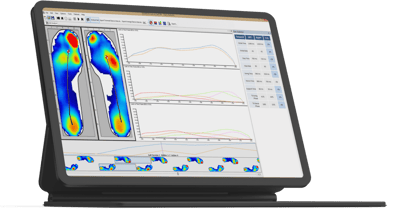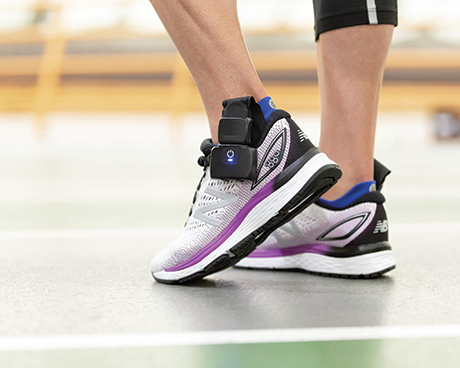
How to Choose the Right Foot Plantar Pressure Measurement System
Finding the Right System That Can Identify Common Orthopaedic Issues
The human foot is a marvel of evolutionary engineering. It has 26 bones, 33 joints, and more than a hundred soft tissue elements: muscles, ligaments and tendons. It forms the base of the leg and the foundation of the entire body’s movement. Ensuring proper foot performance is critical to anyone’s healthy functioning, let alone specialised individuals such as athletes.
Knowing how it works is not quite as simple as understanding that its function is important. That’s where a quality foot plantar pressure measurement system comes in. Whether you’re using it to create orthotics to correct a gait impairment or accommodate the needs of high-performance athletes, a sensitive system with many data points has huge potential.
Even more helpful? Insoles and other technologies are built on scientific solutions and hard data. A foot plantar pressure measurement system is necessary for both. Whether you’re a clinician or a coach, understanding how this works is a must.
Why Is Foot Plantar Pressure Measurement Important?
Foot problems are among the most common orthopaedic issues in older people and those who are very active. According to the Illinois Podiatric Medical Association, “Seventy-five percent of Americans will experience foot health problems of varying degrees of severity at one time or another in their lives.” Moreover, “There are times when you're walking that the pressure on your feet exceeds your body weight, and when you're running, it can be three or four times your weight.”
It is not normal for feet to hurt. Most people in their 30s and beyond have some experience with foot or ankle pain, commonly relating to improper gait or footwear. A foot plantar pressure measurement system can help determine where that pain is coming from. It can also:
- Play a role in screening, diagnosing and treating those at risk of or already experiencing problems with feet and gait
- Help determine the proper footwear for an individual, depending on their age, physicality, activity level and history
- Assist in the creation of physical therapy and training routines to prevent injuries and pain down the road
The right foot plantar pressure measurement system is valuable in collecting data and providing insights for obvious reasons. Sadly, most technologies do not fit the bill.
Where Foot Plantar Measurement Systems Go Wrong
The idea of most pressure measurement systems is sound enough: create a flexible surface embedded with hundreds of sensors that register how movement impacts various areas of the foot. Using this data, create a plantar pressure map. While almost any system will provide some valuable data, many suffer from a number of drawbacks. For instance:
- They aren’t flexible enough: Because of this, they fail to make proper contact with the foot in all cases.
- They are uncomfortable: This makes them less likely to get used properly or may change the person's gait trying to adjust to the unpleasant sensation.
- They are expensive: This is prohibitive to clinicians, who would like to take such measurements but may not have the budget at their practices.
- They aren’t sensitive enough: Some systems need more time and exercise to gather data, making them inefficient devices.
- They are located in the wrong place: If a measurement device is outside the shoe, it is missing a lot of the most sensitive data between the foot and insole.
So what exactly does a quality foot plantar pressure measurement system look like?
Getting Accurate Foot Plantar Pressure Measurement Data
By contrast, a good foot plantar pressure measurement system will be flexible, conform easily to the foot, wear comfortably, and not break the bank. It will also reside inside the shoe to make efficient contact with the foot and register the best data. This enables the highest utility for footwear evaluation, gait analysis, diagnosis of pathologies and design of training programs.
The process for gathering data is as follows:
- Insert the sensors above the current insoles.
- Configure the recording session using a computer or smartphone insoles, enabling it to wirelessly transmit information via Bluetooth or to record on-board.
- Follow the real-time display of readings or download session to the software.
- Analyse incoming data for metrics such as mean and peak pressure, load distribution, the center of pressure and gait cycle timing.
- Use data to determine pressure points, pathologies and possible paths forward.
Moreover, an accurate foot plantar pressure measurement system will remain stable both in stasis (the foot is not moving) and dynamic (the foot is in motion) environments. That includes inside the lab, outdoors or any other setting.
Get Cutting-Edge Foot Plantar Pressure Measurement System Equipment Today
Now that you understand the purpose and functioning of the device, all that remains is to choose a cutting-edge, proven-by-science foot plantar pressure measurement system. XSENSOR can help. We offer a variety of technologies for pressure mapping, including top-shelf gait-mapping systems that help practitioners gather, analyse and diagnose granular plantar pressure data.
Our systems provide real-time, lightning-quick feedback during motionless stance, weight shift, swing phase, and gait cycle – from one surface contact to the next. We enable you to gather visual imagery and hard data in droves, which is why we outperform any other technology in the industry. Plus, with hardware that stands up to repeated use and needs much less calibration than similar systems, you can work efficiently all day long.
Ready for a foot plantar pressure measurement system that remains reliable, accurate and useful throughout its life? We’re here to help with industry-leading products such as insole sensors and stance pad sensors, allowing you to make the most of your measurements. And more importantly, allowing you to help people treat foot problems quickly and effectively.



